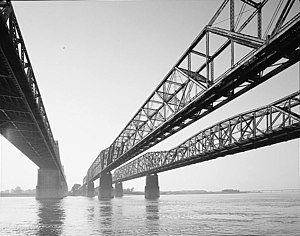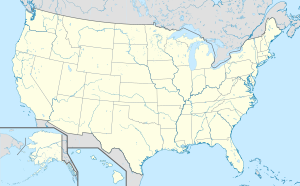Frisco Bridge
Coordinates: 35 ° 7 '43 " N , 90 ° 4' 35" W.
| Frisco Bridge Memphis Bridge |
||
|---|---|---|
| Memphis Bridge (center), Memphis-Arkansas Bridge (left), Harahan Bridge (right) | ||
| use | Railway bridge | |
| Crossing of | Mississippi River | |
| place | Memphis , Tennessee / West Memphis , Arkansas | |
| Entertained by | BNSF Railway | |
| construction | Gerber girder bridge | |
| overall length | 1528 m | |
| width | 9.1 m | |
| Number of openings | five + viaduct | |
| Longest span | 241 m | |
| Clear height | 22.86 m above HW | |
| start of building | 1888 | |
| opening | May 12, 1892 | |
| planner | George S. Morison | |
| location | ||
|
|
||
The Frisco Bridge , formerly Memphis Bridge called, is a railway bridge over the Mississippi River between Memphis (Tennessee) and West Memphis ( Arkansas ), by the BNSF Railway operates one of the seven North American Class 1 railways .
location
The single-track Frisco Bridge, completed in 1892, is framed downstream by the Memphis & Arkansas Bridge , a four-lane highway bridge opened in 1949, and upstream by the double-track Harahan Bridge, which opened in 1916 . The Hernando de Soto Bridge (1973), which is also occasionally mentioned, is a six-lane motorway bridge with two distinctive arches about three kilometers upstream.
Surname
The bridge belonged to the St. Louis - San Francisco Railway ( Frisco for short ), a predecessor of the BNSF Railway. At that time it was officially called The Great Bridge at Memphis or simply Memphis Bridge , sometimes also The Kansas City and Memphis Railway Bridge . When the Harahan Bridge was opened next to it for the Chicago, Rock Island and Pacific Railroad (today Union Pacific Railroad ), it was now called the Frisco Bridge for easy differentiation after its owner .
description
The Memphis Bridge was the first and for a long time the only fixed crossing over the Mississippi below St. Louis. In the mid-1880s, ten railway lines ended in Memphis, whose passengers and goods were laboriously transported to the other bank by steamship.
The bridge was built between 1888 and 1892 by the Kansas City and Memphis Railway and Bridge Company for the Kansas City - Memphis - Birmingham route on the Kansas City, Fort Scott and Memphis Railroad (later St. Louis - San Francisco Railway ).
It was planned by George S. Morison and is considered the last and at the same time the largest of his numerous truss bridges. In addition to other experts, Ralph Modjeski was involved in the design and Alfred Noble and Walter E. Angier in the construction.
The Memphis Bridge had because of the official requirements for a 235 m (770 ft ) wide passage at that time with 241 m the longest span in North America (without suspension bridges) and was worldwide only by the recently opened Forth Bridge in Scotland and the Lansdowne Bridge at that time British India or in today's Pakistan exceeded. Its clear height of 22.86 m (75 ft) above high water is also due to a request by the authorities. It was also one of the first bridges in the world with a superstructure made entirely from Siemens-Martin steel .
The bridge consists (from west to east) of a 711.4 m (2334 ft) long foreland bridge with solid wall girders on scaffolding pillars, a truss girder bridge with an overhead carriageway (103.25 m or 338 ′ 9 ″) to the first one close to the bank Stream pillar , the actual Gerber girder bridge with spans of 189.29 m + 189.29 m + 240.92 m (over the shipping channel) + 68.93 m (over the eastern bank) and a 25.8 m long girder bridge to the abutment. It is therefore 1528.81 m (5015.8 ft) long in total. From a structural point of view, the truss cantilevered over the central opening 51.63 m (169 ′ 4 ½ ″) over the other two openings. The 137.67 m (451 '8 ″) long suspension beam above the western opening rests on the first pillar, the other suspension beam above the navigation channel is supported by the truss, which is also 51.63 m above the easternmost one from the bank River pillar protrudes away.
Its four river piers, two of which are almost on the bank, had to be built with caissons because of the sandy subsoil, which were sunk almost as deep as those of the Eads Bridge in St. Louis . Attempts were made to prevent the caisson disease , which was not yet understood at the time , by the fact that the workers only worked three times a day for 45 minutes in the air pressure of 3.5 atm and were proud that only four deaths occurred.
The bridge should also allow vehicles and pedestrians to cross the river. Therefore, at 9.1 m (30 ft), it was wider than required for a single-track railway. The space between and next to the rails was laid out with wooden planks and could thus be used as a roadway. Before a train arrived, people and vehicles had to leave the bridge, then the train was given free travel.
The Frisco Bridge was added to the list of Historic Civil Engineering Landmarks by the American Society of Civil Engineers in 1987.
In 2000, around 30 freight trains crossed the bridge every day, carrying 60 million tons of freight a year, mostly coal and wheat.
See also
Web links
- Historic American Engineering Record (Library of Congress) - Survey number HAER TN-14, Memphis Bridge
- Frisco Railroad Bridge Historical photos with descriptions
- Photos from the construction of the Frisco Bridge, donated by Estelle Angier. Digital Archive of the Memphis Public Library.
Individual evidence
- ↑ a b c The Frisco Bridge (with schematic drawing) on Historic Memphis Bridges
- ↑ There are at least 42 other bridges in the USA with the Frisco part of their name ; see. the query on Bridgehunter
- ↑ Unless otherwise stated, the description is based on the report by John W. Hronek, Ron G. Berry: Rehabilitation and Strengthening of Burlington Northern Santa Fe Railway Bridge 482.1 over the Mississippi River, Memphis, Tennessee. September 2000 ( digitized PDF 779 kB)
- ^ Martha Carver: Tennessee's Survey Report for Historic Highway Bridges. Tennessee Department of Transportation, 2008, pp. 359-362, here p. 361.
- ^ Memoir of Walter Eugene Angier. American Society of Civil Engineers, from Minerva Systems (Dr. Cora Angier Sowa), accessed February 10, 2018.
- ↑ a b The new Mississippi Bridge at Memphis. In: Centralblatt der Bauverwaltung, XIII. Volume, No. 10 (from March 11, 1893), p. 108 ( digitized , on opus.kobv.de)

